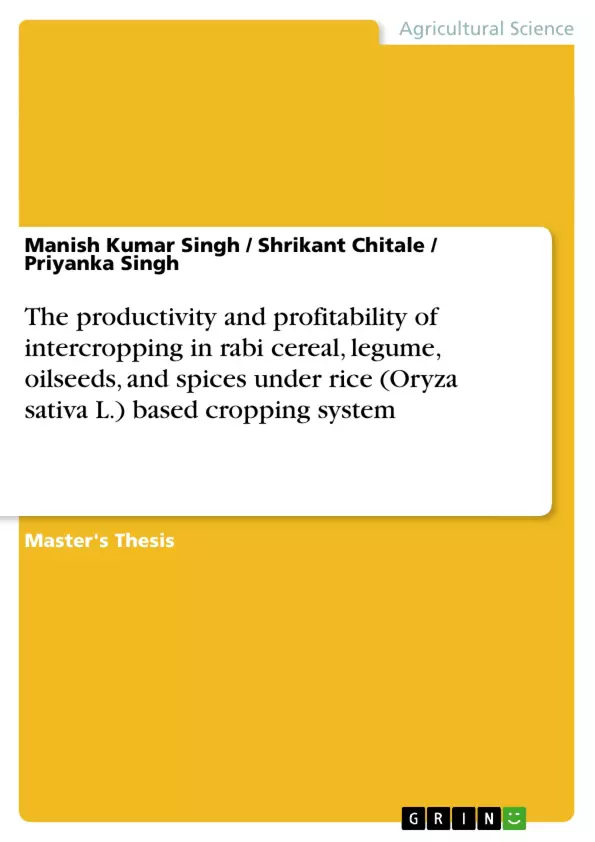Rice farmers are mostly involved in monoculture practices. This deprives the land for growing other food crops. Hence, a better alternative of mono/sole cropping is required to overcome this shortcoming. Therefore, a shift from mono cropping to inter/multiple cropping as an excellent strategy for intensifying land use and increasing income and production per unit area and time is appreciated. Keeping this view in mind, the experiment was conducted during the Kharif and Rabi seasons of 2009-10 at University Research cum Instructional Farm, IGKV, Raipur, Chhattisgarh, India. The major objectives were to assess the production potential and economic viability of different rabi intercropping under rice based cropping systems and to identify the suitable/ remunerative rice based cropping systems with vegetables and oilseeds intercrops.
Inhaltsverzeichnis (Table of Contents)
- INTRODUCTION
- REVIEW OF LITERATURE
- Effect of cropping systems on
- Growth and yield of rice
- Total productivity of system including field crops
- Total productivity of system including vegetables
- Total productivity of system with intercrop
- Effect of cropping systems on soil fertility status
- Effect of cropping systems on weed dynamics
- Water use efficiency
- Economic viability
- Employment generation, production and land utilization efficiency
- Energetics
- Effect of cropping systems on
- MATERIALS AND METHODS
- Geographical Situation
- Climatic condition
- Weather condition during crop growth
- Cropping history of the experimental field
- Physico-chemical characteristics of soil
- Experimental details
- Test crops
- Rice (Oryza sativa)
- Wheat (Triticum aestivum L.)
- Castor (Ricinus communis)
- Lentil (Lens culinaris MediK.)
- Mustard (Brassica juncea)
- Sunflower (Helianthus annuus L.)
- Fenugreek (Trigonella foenumgraceum)
- Onion (Allium cepa L.)
- Coriander (Coriandrum sativum L.)
- Experimental details and cultural operations
- Seed treatment
- Transplanting of rice
- Cultural Schedule
- Harvesting and threshing
- Studies on crops
- Pre-harvest observation
- Plant population (No. m-²)
- Plant height (cm)
- Dry matter accumulation (g plant-¹)
- Leaf area index (LAI)
- Weed studies
- Weed density
- Dry weight of weeds
- Post harvest observations
- Yield components
- Panicles plant-¹
- Grains panicle-¹
- Panicle length (cm)
- Test weight (g)
- Biomass production
- Grain yield (q ha-¹)
- Straw yield (q ha¨¹)
- Harvest index (%)
- Wheat equivalent yield (kg ha -¹)
- Yield components
- Pre-harvest observation
Zielsetzung und Themenschwerpunkte (Objectives and Key Themes)
This thesis investigates the productivity and profitability of intercropping in a rice-based cropping system, focusing on rabi cereal, legume, oilseeds, and spices. The objectives are to evaluate the impact of intercropping on various aspects of the cropping system, including:- Yield and productivity of the main crop (rice) and intercrops
- Soil fertility and nutrient dynamics
- Weed management
- Economic viability and profitability
- Land and resource utilization efficiency
Zusammenfassung der Kapitel (Chapter Summaries)
- Introduction: The chapter sets the context for the study, highlighting the importance of sustainable agriculture practices, particularly intercropping, in improving crop yields and resource utilization efficiency. It also outlines the specific objectives and research questions that guide the investigation.
- Review of Literature: This chapter comprehensively explores existing research on the effects of different cropping systems, including intercropping, on various aspects of crop production, soil fertility, weed management, water use efficiency, economic viability, and employment generation. It provides a theoretical foundation for the study and identifies potential benefits and challenges associated with intercropping.
- Materials and Methods: This chapter details the study design, experimental setup, and methodologies used for the research. It includes information on the location, climatic conditions, soil characteristics, test crops, experimental treatments, cultural practices, data collection methods, and statistical analysis techniques employed. The chapter also provides detailed descriptions of the different intercropping combinations and management practices investigated.
Schlüsselwörter (Keywords)
This research focuses on intercropping, rabi crops, rice-based cropping system, productivity, profitability, yield, soil fertility, weed management, economic viability, resource utilization efficiency, and sustainable agriculture practices.- Arbeit zitieren
- Manish Kumar Singh (Autor:in), Shrikant Chitale (Autor:in), Priyanka Singh (Autor:in), 2010, The productivity and profitability of intercropping in rabi cereal, legume, oilseeds, and spices under rice (Oryza sativa L.) based cropping system, München, GRIN Verlag, https://www.grin.com/document/213751



